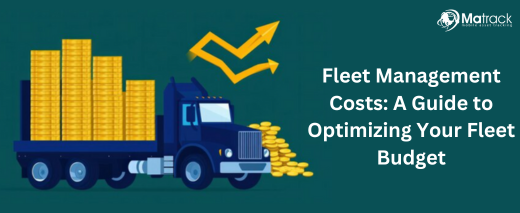Key Takeaways
- Fleet management costs include fixed expenses like vehicle purchases and insurance, and variable costs like fuel and maintenance.
- Calculating cost-per-mile helps track spending, identify inefficiencies, and improve fleet budgeting.
- Technology such as GPS tracking, telematics, and AI reduces costs by optimizing routes, monitoring fuel use, and improving maintenance.
- A strategic fleet budget, combined with efficient driver management and predictive maintenance, ensures long-term cost control.
Understanding Fleet Management Costs
Managing a fleet isn’t just about having vehicles on the road, it’s about handling a range of expenses that can quickly add up. These costs fall into two main categories: fixed costs and variable costs.
Fixed Costs
Some costs don’t change no matter how much or how little your fleet is used. These include:
- Vehicle Purchase or Lease Costs – Whether you buy or lease, this is one of the biggest upfront expenses in fleet management.
- Insurance Premiums – Fleet insurance is necessary, but its cost depends on the type of vehicles, number of drivers, and safety history.
- Depreciation – Every vehicle loses value over time, which affects its resale price when it’s time to replace it.
- Licensing & Registration – Government fees that must be renewed periodically to keep your fleet legal and operational.
Variable Costs
Unlike fixed costs, variable costs shift depending on vehicle usage, fuel prices, and maintenance needs. Some of the most common variable expenses include:
- Fuel Costs – Fuel is often the biggest ongoing expense for any fleet. It fluctuates based on gas prices, driving habits, and route efficiency.
- Maintenance & Repairs – Routine servicing, tire replacements, and unexpected breakdowns all contribute to fleet expenses.
- Toll & Parking Fees – Depending on where your vehicles operate, these costs can vary significantly.
- Driver Salaries & Training – Hiring and keeping skilled drivers comes with wages, benefits, and training costs to ensure safe and efficient operations.
Factors Affecting Fleet Expenses
Several internal and external factors impact fleet expenses. Companies that proactively manage these elements can significantly reduce costs.
Fuel Price Volatility
Fuel costs account for 30-40% of total fleet expenses. Prices fluctuate due to market conditions, global demand, and geopolitical factors. Implementing fuel-efficient strategies can reduce overall fuel consumption.
Vehicle Selection and Lifecycle
The type of vehicle in a fleet affects operating costs. Fuel-efficient, durable, and low-maintenance models lower expenses in the long run. The decision to lease or purchase also impacts the fleet budget.
Driver Behavior
Aggressive driving, idling, and inefficient route planning increase fuel consumption and maintenance costs. Implementing driver monitoring systems and training programs improves efficiency.
Maintenance Strategy
Proactive maintenance reduces breakdowns and costly repairs. Adopting a predictive maintenance approach helps minimize unplanned downtime and extends vehicle lifespan.
Compliance and Regulations
FMCSR regulations impose costs related to vehicle emissions, safety inspections, and driver certifications. Non-compliance can lead to hefty fines, increasing fleet expenses.
How to Calculate Cost-per-Mile to Improve Fleet Efficiency
To calculate cost-per-mile, use this formula:
Cost-per-Mile =Total Miles Traveled ÷ Fixed Costs+Variable Costs
Steps to Calculate:
- Add Fixed Costs – Includes vehicle payments, insurance, depreciation, and registration fees.
- Add Variable Costs – Covers fuel, maintenance, tolls, parking, and driver wages.
- Divide by Total Miles Traveled – Use odometer readings or fleet tracking data.
Example Calculation:
- Fixed Costs: $20,000
- Variable Costs: $30,000
- Miles Traveled: 50,000
Cost-per-Mile =50,000 ÷ 20,000+30,000=1.00
The cost-per-mile is $1.00, meaning each mile costs the fleet $1.
Why It Matters:
- Identifies cost inefficiencies.
- Improves budget accuracy.
- Supports leasing, fuel, and maintenance decisions.
Tracking cost-per-mile helps reduce expenses and optimize fleet performance.
Effective Strategies for Fleet Cost Management
Optimizing fleet management costs requires a combination of technology, strategic planning, and operational efficiency. Here are the top strategies for effective fleet cost management.
Implement a Fleet Management System (FMS)
A Fleet Management System (FMS) provides real-time data on vehicle performance, fuel usage, and maintenance needs. Key benefits include:
- Route Optimization – Reduces fuel consumption and travel time.
- Driver Monitoring – Identifies and corrects inefficient driving habits.
- Automated Maintenance Alerts – Prevents costly breakdowns.
Optimize Fuel Management
Reducing fuel consumption can lead to significant cost savings. Strategies include:
- Fuel Cards – Track fuel purchases and prevent unauthorized transactions.
- Telematics Integration – Provides data on fuel efficiency and driver performance.
- Alternative Fuel Vehicles – Electric and hybrid options lower fuel dependency.
Check out: 10 Best Fleet Fuel Cards
Adopt Predictive Maintenance
Preventive maintenance is essential for avoiding unexpected repair costs. A predictive approach involves:
- AI-Driven Diagnostics – Identifies issues before they become expensive problems.
- Tire Pressure Monitoring Systems (TPMS) – Ensures proper tire inflation, reducing fuel waste.
- Automated Service Scheduling – Keeps maintenance on track without manual oversight.
Optimize Fleet Utilization
Underutilized vehicles increase unnecessary expenses. Companies should:
- Analyze Vehicle Usage Data – Identify which vehicles are underused and optimize deployment.
- Pool Vehicles for Shared Usage – Reduces the need for excess vehicles.
- Outsource Non-Essential Routes – Lowers overhead costs when outsourcing is more cost-effective.
Control Insurance Costs
Fleet insurance is a major fixed expense. To reduce premiums:
- Encourage Safe Driving Practices – Reduces accident-related claims.
- Bundle Insurance Policies – Negotiates better rates with providers.
- Review Coverage Annually – Ensures policies align with fleet needs.
Improve Driver Training and Engagement
Drivers play a crucial role in controlling fleet expenses. Effective training programs:
- Reduce Fuel Waste – Teaching eco-driving techniques lowers fuel consumption.
- Lower Maintenance Costs – Proper vehicle handling minimizes wear and tear.
- Decrease Accident Rates – Safer driving reduces insurance claims and legal expenses.
Explore Leasing vs. Buying
Choosing between leasing and purchasing impacts the fleet budget. Consider:
- Leasing Benefits – Lower upfront costs, predictable monthly expenses, and access to newer models.
- Buying Advantages – Long-term cost savings for high-mileage fleets and full asset ownership.
Technology’s Role in Fleet Cost Management
GPS fleet tracking helps fleets cut fuel costs by optimizing routes and reducing unnecessary mileage. It also enhances security by tracking vehicle locations and preventing unauthorized use.
Telematics systems provide real-time data on driver behavior, fuel usage, and vehicle performance. Fleet managers can use this information to reduce excessive idling, improve fuel efficiency, and lower maintenance expenses.
AI-powered analytics identify hidden cost drivers by analyzing fuel consumption, repair trends, and driving patterns. Automated reporting tools make it easier to track expenses, streamline budgeting, and ensure compliance with industry regulations.
How to Build an Effective Fleet Budget
A well-planned fleet budget ensures cost control and profitability. Steps to create a robust budget include:
Analyze Past Expenses
Review historical data on fuel, maintenance, insurance, and operational costs to identify spending patterns.
Forecast Future Costs
Consider industry trends, fuel price predictions, and vehicle lifecycle costs when projecting expenses.
Set Cost Reduction Goals
Establish achievable targets, such as reducing fuel costs by 10% or cutting maintenance expenses by 15%.
Implement Cost Monitoring Tools
Use fleet expense tracking software to monitor spending in real time and adjust strategies accordingly.
Review and Adjust Regularly
A fleet budget should be dynamic. Conduct quarterly reviews to adapt to changing business needs and economic conditions.
Conclusion
Controlling fleet costs requires smart planning, technology, and efficient operations. Businesses that manage expenses well can cut costs, improve efficiency, and increase profits.
A strong fleet budget helps companies track spending and stay financially stable. Using technology, training drivers, and maintaining vehicles properly are the best ways to reduce costs and run a profitable fleet.

